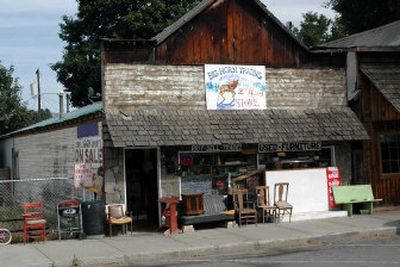Regional history hotbed

It’s really pretty amazing, the old town of Kettle Falls, not that there is much to see. There are just a few foundations, cement slabs that were floors to homes and sidewalks with tree roots pushing them up at odd angles. It’s like the entire town just vanished, and in fact, it did.
Just imagine how you would react if the U.S. government told you that you would have to move your house or watch it burn. That’s what happened to the 300 residents in Kettle Falls. Actually that is what happened to the 3,000 inhabitants of 11 towns that had unfortunately built in the flood plain that was filling up with water behind Grand Coulee Dam during the 1930s. Many of the homes were moved to the new Kettle Falls town site or to the nearby town of Colville.
This area in northeast Washington was on the map way before explorer David Thompson and the British established a trading post on a hill near the falls. Native Americans have been meeting, fishing for salmon and trading here for more than 9,000 years. Even tribes that were enemies made a truce and fished side by side at Kettle Falls. Thompson reported that the Indians would have an average harvest of 1,000 fish a day to preserve and use over winter. Kettle Falls was more like a series of cascades that made catching fish easy. It was reported that on the best day of fishing at the falls the Indians caught as many as 1,700 salmon averaging 30 pounds each. During the fishing season, the tribes appointed a salmon chief who distributed the fish fairly among the tribes represented at the falls.
All the activity at the falls attracted the attention of the Hudson’s Bay Co., which built a fort and agriculture center within sight of the falls. By 1840 the post was processing 18,000 fur pelts a year.
Kettle Falls was the end of navigable water up the Columbia River, so all goods, supplies, lumber and pelts on steamboats were loaded or unloaded near the town. Fort Colvile (original spelling) was built by the falls. The area also produced much of the agricultural produce that was shipped downriver.
Kettle Falls got its name from early boatmen that noticed that there were curious holes in the hard stone beneath the falls. Some of the round holes could hold two adult men and were six feet deep. They looked like kettles. Like the old town site, the falls also has disappeared under the back water of Grand Coulee Dam.
The Jesuit priest, Father Ravalli, arrived at this site and enlisted the local Indians to build a small mission named St. Paul. Ravalli’s name may sound familiar because later he also took the lead with the Coeur d’Alene Indians to build the Old Mission at Cataldo. St. Paul Mission is now restored with a quarter-mile-long interpretive trail to an overlook of Lake Roosevelt. A large boulder along the trail bears many V-shaped grooves Indians made while sharpening their knives for processing salmon.
The Kettle Falls library offers numerous historic photos of the old town of Kettle Falls and the logging industry that still is prevalent in the area. Like most visits to a library (or the Internet), getting sidetracked and reading unrelated topics becomes part of the fun. In the Kettle Falls library there is a quote from the town’s early newspaper, dated June 8, 1911, written by a young girl and titled, “Men.” It reads: “Men are what women marry. They drink and smoke and swear, but don’t go to church. Perhaps if they wore bonnets they would. They are more logical than women and more zoological. Both men and women sprung from monkeys, but women sprung further than men.”
There also is a historic hydroelectric plant to explore. The Kettle Falls area is a hotbed of regional history. Besides the relocation of the town in the 1930s, the falls, the Native American fishing sites and historical encampment, the mission, the fort, the logging and David Thompson’s memoirs, this region is a very interesting place to visit. The drive will take you through ponderosa pine forests and mountains similar to Kootenai County, but without the traffic.